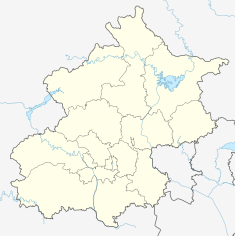
Back Hemeltempel Afrikaans معبد السماء Arabic معبد السماء ARZ Templu del Cielu AST Səma məbədi Azerbaijani Tian Tan BAN Храм Неба Byelorussian Храм на небето Bulgarian Temple del Cel Catalan Chrám nebes Czech
This article includes a list of general references, but it lacks sufficient corresponding inline citations. (October 2016) |
| Temple of Heaven | |
|---|---|
 Hall of Prayer for Good Harvests, the largest building in the Temple of Heaven | |
| Location | Dongcheng, Beijing, China |
| Coordinates | 39°52′56″N 116°24′24″E / 39.8822°N 116.4066°E |
| Built | 1406–1420 (Ming dynasty) |
| Website | tiantanpark.com |
| Official name | Temple of Heaven: an Imperial Sacrificial Altar in Beijing |
| Type | Cultural |
| Criteria | i, ii, iii |
| Designated | 1998 (22nd session) |
| Reference no. | 881 |
| Region | Asia-Pacific |
| Temple of Heaven | |||||||||||||||||||
|---|---|---|---|---|---|---|---|---|---|---|---|---|---|---|---|---|---|---|---|
 "Temple of Heaven" in Simplified (top) and Traditional (bottom) Chinese characters | |||||||||||||||||||
| Simplified Chinese | 天坛 | ||||||||||||||||||
| Traditional Chinese | 天壇 | ||||||||||||||||||
| Literal meaning | "Altar of Heaven" | ||||||||||||||||||
| |||||||||||||||||||
The Temple of Heaven (simplified Chinese: 天坛; traditional Chinese: 天壇; pinyin: Tiāntán) is a complex of imperial religious buildings situated in the southeastern part of central Beijing. The complex was visited by the Emperors of the Ming and Qing dynasties for annual ceremonies of prayer to Heaven for a good harvest. The Temple of Heaven was inscribed as a World Heritage site in 1998 and was described as "a masterpiece of architecture and landscape design which simply and graphically illustrates a cosmogony of great importance for the evolution of one of the world's great civilizations..." as the "symbolic layout and design of the Temple of Heaven had a profound influence on architecture and planning in the Far East over many centuries."[1]
- ^ "Temple of Heaven: an Imperial Sacrificial Altar in Beijing - UNESCO World Heritage Centre". Whc.unesco.org. 1998-12-02. Archived from the original on 2008-08-01. Retrieved 2016-10-31.

